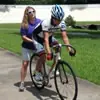
Come January, the Internet will be flooded with articles discussing how to accomplish your goals for the year. By waiting until spring to begin planning and training for your goals, you could put yourself in a time crunch that isn't necessary.
Whether you're a recreational rider or a competitive cyclist, begin by determining what you need to work on to accomplish your goals. If you participated in a 100-mile ride but could only ride the first 50 miles because of back pain, now is the time to work on figuring out why you're having pain on longer rides. Is it weakness? Or is it a poor bike fit?
The body takes time to adapt to training. Areas of weakness will take longer to fix. Begin any good training plan by discovering what your limiters are. When you can discover what kept you from succeeding last year, you're one step closer to accomplishing your goals this time around. And the sooner you start the better.
Here are a few specific limiters to consider (and how to correct them) as you develop a training plan for next year.
Back Pain
If back pain kept you from finishing an event or kept you from reaching a time goal, make an appointment with your doctor. It's better to get a serious problem out of the way first instead of exacerbating symptoms. If the doctor says you're okay, move to step two.
If you haven't had a good bike fit, get one. Most back pain stems from poorly adjusted saddle height and handlebar reach. While it might not be a problem for the first 20 miles, long distances have a way of uncovering errors in your position.
Once you've had a bike fit, determine if you still feel stiff or have pain after a long ride. If you do, then the problem is likely weakness caused by a lack of core strength. Center your offseason workout routine to build strength in these areas.
Lower Extremity Weakness
As with back pain, a bike fit and an exercise plan geared towards building strength is a good starting point to address pain or muscular deficiency. The more time you spend in the saddle, the less likely that muscular fatigue will be an issue.
In Shannon Sovndal's Cycling Anatomy, she recommends a strength-building exercise called "Goalie's" that works your legs, core and arms. To perform a Goalie:
- Hold a medicine ball at chest height. Stand in front of a platform or step with feet shoulders-width apart.
- With a bounding movement, step onto the platform with one leg. Drive your non-weight-bearing knee up towards your chest. Straighten the supporting leg. Extend both arms up so that the medicine ball is raised above your head. The move is completed with a toe raise on the supporting leg.
- Use controlled movements to step back to the starting position. Repeat using the opposite leg.
The "Spinning Drill" is another exercise that will help build strength. Please note: If you can't spin at the recommended 120 rpm, start at 60 rpm and increase rpm by 10 at each minute. Recover the same amount of time you spin (4 minutes spinning = 4 minutes recovery or 3 minutes spinning = 3 minutes recovery).
- Place your bike on a trainer.
- Warm up for 20 minutes.
- Shift gears so you can spin:
- 90 rpm for 1 minute.
- 100 rpm for 1 minute.
- 110 rpm for 1 minute.
- 115 rpm for 1 minute.
- 120 rpm for 30 seconds.
- Recover and spin easy for 5 minutes.
- Repeat 3 times.



